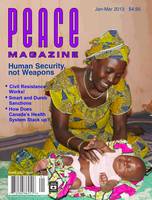
Peace Magazine January-March 2013, page 29. Some rights reserved.
Search for other articles by Ken Simons here
By Marcello Di Cintio. Fredericton: Goose Lane, 2012.
Early one morning in January 2011, somewhere along the 4000-km long fence which separates India from Bangladesh, Felani Khatun died. Snagged on the barbed wire as she climbed the barrier, she had been shot by Indian border guards and left to bleed to death. Four hours later, the soldiers finally brought her body down.
It was her wedding day. The fifteen-year-old was to marry a cousin from the Bangladeshi side of the border, and her father had paid some smugglers to help her get there on time.
Tangled among the multiple tragedies represented in this incident is one question which can’t be avoided: Why did India and Bangladesh even need to be walled off from one another, given the history of good relations between the two countries? What’s more, the people living along the border spoke the same language, followed the same religion, and frequently had family on the other side.
When work on the fence began in the late 1980s, the official line was that it was needed to stem illegal immigration (the bogey of terrorism was added later). But there were also atavistic reasons. As Marcello Di Cintio writes in Walls: Travels Along the Barricades,
“The Wall screams for the mingling across the line to stop. The Wall christens the villagers Indians and warns them that those on the other side are not. Three strands of barbed wire obliterated all they had in common—which was everything.”
In this fascinating book, Di Cintio visits seven borders blighted by fences, walls, or (in one case) fortified earthworks. The shadow of the Berlin Wall runs throughout the book: the corroding psychological effects of living behind a wall were well-documented in East Germany at the time. Psychiatrist Dietfried M¸ller-Hegemann even coined a word to describe the syndrome: Mauerkrankheit, or “wall disease.” He noted that suicide attempts, alcoholism, and other indicators of distress were more common the closer you were to the wall. Even though the wall enclosed all East Germans, the nearness of its presence had a destructive power of its own.
Some of the walls visited by Di Cintio extend the full length of a national border: the Indo-Bangladeshi fence, the sand berm which separates Moroccan-occupied Western Sahara from the Polisario-controlled interior; the US-Mexico border fence, fortified in recent years in a futile attempt to stop economic migrants from crossing illegally; and the West Bank wall or “separation barrier,” notorious for the destruction of Palestinian villages and farms.
Di Cintio also visits some urban walls: in Nicosia, dividing the Turkish-Cypriot and the Greek-Cypriot sides of the national capital, much as the Berlin Wall did in its day; in Belfast, where the misleadingly named “Peace walls” are many, some surrounding neighborhoods of no more than a block or two, and continue to be built even after the formal end of the Troubles; and the walls around the Spanish North African enclaves of Ceuta and Melilla, the final waystation for refugees and economic migrants seeking to reach mainland Europe.
Finally, there’s a look at the l’Acadie fence, built in the early 1960s to separate the middle-class town of Mount Royal (now a borough of Montreal) from the working-class district of Parc-Extension. While there are no armed guards, no watchtowers, and no tripwires, this two-metre high chain-link fence has been an apt symbol for class division but has somehow survived repeated attempts to legislate it out of existence.
As Di Cintio recounts his conversations with people on both sides of the barriers, he helps us gain a sense of why walls seem to give a sense of security to some, insecurity to others, and a deep-seated malaise to all: to the wall-builders as much as to the people who have been excluded by them.
Reviewed by Ken Simons, managing editor of Peace.

Peace Magazine January-March 2013, page 29. Some rights reserved.
Search for other articles by Ken Simons here